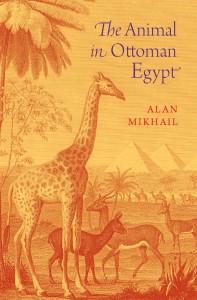The Animal in Ottoman Egypt. New York: Oxford University Press, 2014.
Winner
of the
2014 Gustav Ranis International Book Prize
Since humans first emerged as a distinct species, they have eaten, fought, prayed, and moved with other animals. In this stunningly original and conceptually rich book, historian Alan Mikhail puts the history of human-animal relations at the center of transformations in the Ottoman Empire from the sixteenth to the nineteenth centuries.
Mikhail uses the history of the empire’s most important province, Egypt, to explain how human interactions with livestock, dogs, and charismatic megafauna changed more in a few centuries than they had for millennia. The human world became one in which animals’ social and economic functions were diminished. Without animals, humans had to remake the societies they had built around intimate and cooperative interactions between species. The political and even evolutionary consequences of this separation of people and animals were wrenching and often violent. This book’s interspecies histories underscore continuities between the early modern period and the nineteenth century and help to reconcile Ottoman and Arab histories. Further, the book highlights the importance of integrating Ottoman history with issues in animal studies, economic history, early modern history, and environmental history.
Carefully crafted and compellingly argued, The Animal in Ottoman Egypt tells the story of the high price humans and animals paid as they entered the modern world.
Watch Alan Mikhail discuss The Animal in Ottoman Egypt.
Reviews
International Journal of Turkish Studies
To set such figures as Napoleon and Mehmet ‘Ali alongside the buffalo cow and the ox in terms of their importance in early modern and modern Egyptian history speaks to the boldness of Mikhail’s latest monograph—one which is bound to excite and to provoke historians of the Middle East and Ottoman Empire in equal measure. . . . Taken as a whole, though, the work is breathtaking, not least insofar as it suggests that the interspecies chasm and gradual removal of animals from human spheres of activity foreshadowed the displacement of humans by machines in work, as well as the marginalization of entire classes of people.
American Historical Review
Mikhail is at his most persuasive when he argues that ecological perspectives, combined with traditional archival and primary research, and “historical context, and even imagination” (p. 12), must be woven together to understand the experiences of all living things in history. That strategy may sound like it would produce an account not unlike the camel of the modern proverb: a horse designed by committee. But in Mikhail’s capable hands, it offers historians of the Middle East a new answer to an old question, as well as a fresh and engaging way for even non-area specialists to think about relations among modernization, energy, and empire.
Environmental History
Well researched and supported by copious archival and manuscript resources from Europe, North America, North Africa, and Asia. . . . Mikhail marshals abundant evidence to support his thesis about the dramatic changes in human-animal relationships wrought by modernization.
Arab Studies Journal
The Animal in Ottoman Egypt covers an astonishing amount of ground. It opens our eyes to dynamics of the animal experience and human-animal relations not only in Ottoman Egypt and the Ottoman Empire more broadly, but also in the Indian Ocean and Mediterranean economies and in Islamic thought going back to the seventh century. For the fields of Ottoman and Middle East history, the book encourages myriad avenues for further research and introduces a rich source base, from understudied rural court records to manuscript collections. It also exposes scholars steeped in area studies to literatures, approaches and arguments with which they may not be otherwise familiar.
J. R. McNeill, Georgetown University, author of Mosquito Empires
Camels, donkeys, dogs, and water buffalo have their histories too, and in this compact book Alan Mikhail deftly shows just how closely intertwined they, and the histories of other animals, were with the human history of Ottoman Egypt. Carefully researched, lavishly illustrated, and engagingly written, this book sets a high standard for the historical study of human-animal relations and opens new vistas on the history of Egypt.
Harriet Ritvo, Massachusetts Institute of Technology, author of The Animal Estate
In this deeply and imaginatively researched book, Alan Mikhail uses insights drawn from the new field of animal history to revisit major transitions in Egyptian history, including modernization, urbanization, and integration into global networks. Particularly striking is the way his argument encompasses both the material conditions of animal existence, such as labor and disease, and the more abstract impact of religion, law, and politics.
Kenneth Pomeranz, University of Chicago, author of The Great Divergence
This is a fascinating book, which uses the diminishing presence of animals in various key locations to shed light on major social transformations in late 18th and early 19th century Egypt. Everything from climate and bacteria to foreign imperialists and their new technologies shaped the new Egypt that we see emerging in this book; each of these agents of change gets its due in Mikhail’s intricate story.
